F-104 Starfighter against MiG-21
Thanks to the efforts of the mass media, the F-104 Starfighter has a reputation for failure. Some nicknames are worth it: " flying coffin ", " husband's killer ", " widow maker " and so on. He is believed to have hopelessly lost air combat with the MiG-21 . However, the attitude towards the F-104 was not always negative everywhere. In Pakistan, for example, he was given the rather reasonable nickname " hooligan ". Canadian pilots sometimes called it the " flying phallus, " which, as you can see, is much better than the " flying scrap, " as the MiG-21 was called at the time. The F-104 Starfighter and MiG-21 were peers when they were at the forefront of the Cold War confrontation. When trying to find out which of these two aircraft is better, it would be wrong to make a comparison by way of their technical characteristics. After all, both fighters performed a relatively wide range of combat missions, and if one aircraft had the upper hand in some important parameter, it still means nothing. It is possible that such qualities were fully sufficient for him to fulfill the task.
Let's start with the engines. In the design of jet engines, American and Soviet designers increased the thrust of their products by increasing the air compression in the compressor. The Americans reached the set point by adding degrees, bringing their number with J79 to 17. But they " knew " their craft well, and the compression of this monster reached a record number - 12. This is the best indicator in the world at the time. It is clear that the by-product was an increase in the size and weight of the engine. Alexander Mikulin took a completely different path. He used a so-called supersonic compressor on his AM-11. In it, thanks to the special profile of the blades, the air flow between them moved faster than the speed of sound. It has only 6 degrees (the first 4 are supersonic ), but at the same time Mikulin managed to achieve a compression of 8.6, while the engine was smaller and lighter than the American. However, the Mikulin jet engine had serious shortcomings. It is very difficult to achieve stable performance from a supersonic compressor. In addition, its blades were subjected to heavy loads and even small scratches could lead to their destruction.
The designers took completely different paths both in terms of ensuring the stability of engine operation and in the fight against pumping. For stable operation, the J79 used rotary compressor vanes. This is a very complex and expensive system. A two-stage compressor was used on the Mikulin engine, which did not require any special equipment. All regulation was provided by different speeds of low-pressure and high-pressure rotors. In general, an engine is considered more advanced if the thrust is achieved with minimal weight and fuel and air consumption. In addition, each additional kilogram of engine weight will increase the weight of the aircraft by approximately 3 kg. The design level of engine perfection can be determined by its specific weight - the ratio of weight to maximum thrust. The smaller it is, the better. As can be seen from the table, A. Mikulina's engine is better.
For engine and hydraulic system maintenance, the MiG-21 was equipped with more than a dozen small caps, which made it difficult for technicians to work. The F-104 had easier access to the engine and hydraulic system. Under the fuselage of the American fighter was a large tilting panel, on the inner surface of which was placed a significant part of the hydraulics. The dimensions of the engine and the range requirements largely determined the overall dimensions of the aircraft. Both fighters had a cylindrical fuselage with great slenderness, they were mid-planes and had one keel.Namely such an appearance of the aircraft, provided low resistance and a path to high speed.

MiG-21PF
The upper location of the stabilizer on the F-104 ( acting as a closing plate ) allowed to place a small keel on the aircraft with an area of 3.6 m, while the MiG-21PF keel is larger - 4.45 m. The so-called " area rule " was not used on both aircraft. At that time it was not yet known in the USSR, and Johnson deliberately abandoned the " rule " because his plane had a very thin wing, which practically did not violate the distribution of cross-sectional areas. So we can talk about a certain unified approach to the design of Johnson and Mikoyan. The sound barrier and the further propulsion of their aircraft were overcome only due to high engine thrust, which negatively affected fuel consumption and engine resources. In terms of maximum aerodynamic finesse, the F-104A slightly outperformed the MiG-21: 8.25 against 8. So both fighters are very similar in aerodynamic properties. Of course, the lift of the F-104 wing was smaller, but this disadvantage was compensated by significantly lower frontal resistance and SPS system ( sduv pograničnogo sloja ).
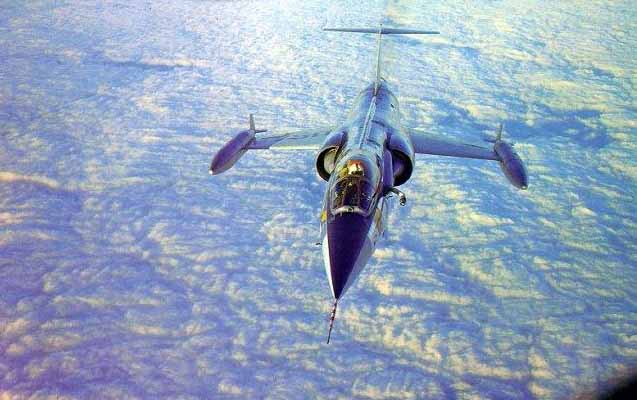
F-104A
Another important parameter of aircraft design excellence is the distribution density ( ratio of kite weight to volume ). For the Starfighter it is 310 kg / m, while for the MiG-21 it is only 200 kg / m. The MiG's worse indicator can be explained by its front air intake and air duct, which pierced the entire fuselage and absorbed the already small useful volume. The " MiG " also lost in the relative volume of fuel tanks (the ratio of their volume to the volume of the aircraft ): about 0.11 against 0.17. According to this indicator, the " Starfighter " surpasses the MiG-23 fighter of the next generation ( 0.15 ). On the F-104A and MiG-21PF, refueling the fuel tanks was performed using a pistol with several filler necks, which complicated and delayed the process and could also cause foreign objects to enter the tanks. For the F-104C, this shortcoming was eliminated by a central refueling system.
Almost all electronic equipment on the MiG-21 was " scattered " in blocks in the free volumes of the nose of the aircraft. Sufficient covers were available for maintenance. The F-104 became one of the first combat aircraft, whose onboard equipment was placed for the most part in one place and in a unified form. This shortened the connection, improved cooling and simplified sealing. The equipment area was located behind the cockpit. The " Starfighter " radar was installed in the cylindrical front area and all connectors for inspection and maintenance were made in the bow. Compared to the MiG, this arrangement provided a weight saving of 20% and a volume saving of 50%.
The MiG-21PF control system included a KAP-2 autopilot, which provided damping of longitudinal oscillations only. The F-104 had a more advanced automatic control system with damping in all three axes. The properties of the American damping improved the accuracy of shooting and ensured that the aiming mark was maintained on the targets with an accuracy of 1 thousandth. In addition, in the maneuvering battle, the Starfighter pilot was greatly helped by the fall warning system and the automaton, which brought the aircraft to lower angles of attack. Thanks to this, the pilot felt freer when maneuvering, he could go to a greater overload. A similar system did not appear in the USSR until the second half of the 1970s on the MiG-23ML . According to the radar's characteristics, the aircraft were about the same. MiG-21PF was equipped with a pulse-type radar - RP-21, which compared to previous modifications significantly expanded its combat capabilities. The radar made it possible to search for an air target between ± 30 ° in azimuth and ± 12 ° in elevation. The bomber's detection range was 20 km and the fighter's range was 7-10 km.Target capture and tracking was performed at a distance of up to 12 km.
MiG-23ML
The station could not detect and track targets in the background of the Earth. At altitudes below 4 km, the station's field of view has narrowed to ± 8 ° or shifted upwards to reduce the effect of interference. The minimum application height was 1,000 m. In rangefinder mode, the range was from 2.5 to 15 km. Antenna gyroscopic stabilization was only available in the altitude channel, and pilots could not divide the field of view among several aircraft in group flight, although experimental flights were performed in the order of the " radar chain ". A similar station was installed on the F-104C , which was part of the fire control system AN / ASG-14T-1 and contained an optical gyroscopically stabilized sight and search pulse radar. The system could only be used in simple weather conditions. The radar could not track the target by an angle - only in distance. Radar viewing angles in azimuth and elevation were 90 °. The maximum detection range for a bomber-type target is 37 km. Capture and enter distance tracking mode at a distance of 16 to 18.5 km. Under interference conditions, the station could indicate the direction to the radiation source.
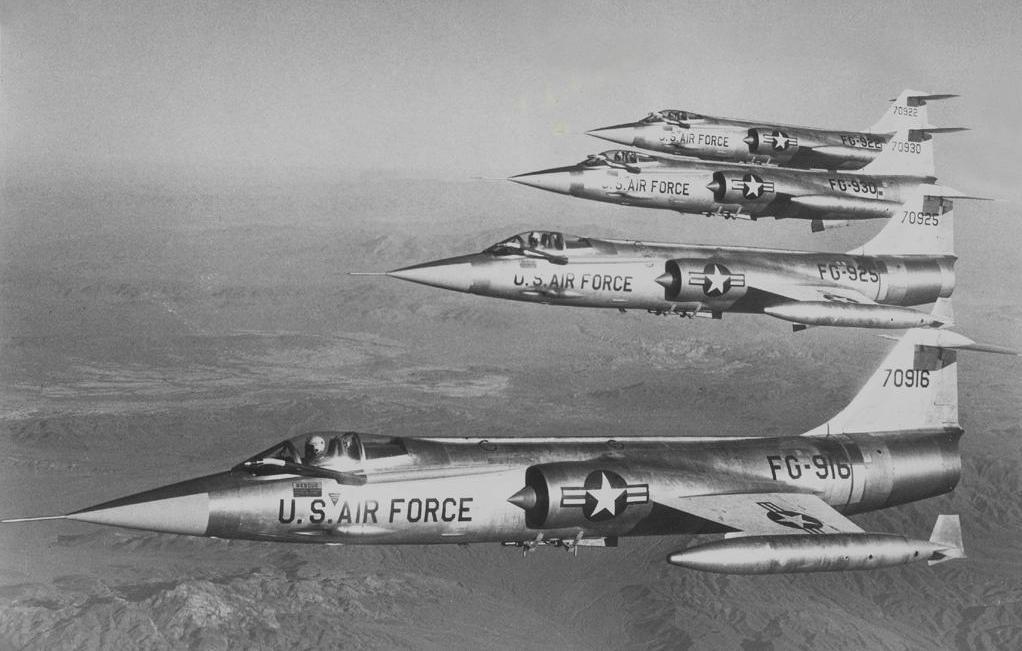
F-104C
An important point was the presence of a missile and SPO warning system on board the F-104C, which allowed the pilot to detect the enemy in the rear hemisphere in time if he turned on the radar due to radiation. By overestimating the capabilities of guided missiles, the cannon armament was first removed from the MiG-21PF. But the first air battles in the local wars proved the haste of such a decision. In order to restore the combat potential of the aircraft, a suspended GP-9 gondola was created with a 23mm double-barreled cannon GS-23 ( 200 rounds ). It turned out that it was so successful that later the MiG-21PF ( FL ) did not enter the fight without the GP-9. It is true that the suspension of the weapon under the fuselage ruled out the possibility of using PTB.
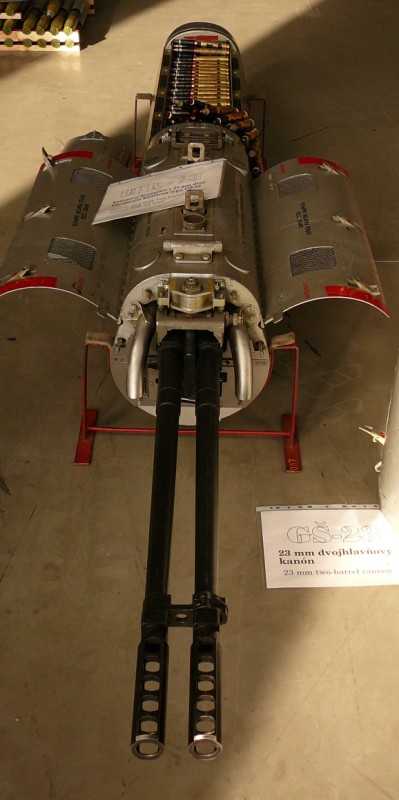
GŠ-23
The Vulcan M61A1 mounted on the Starfighter exceeded the firing rate of the GŠ-23 ( 6000 rounds per minute compared to 3500 at the GŠ ), but had a lower weight of the second salvo. In a second, he sent the enemy only 10.2 kg of grenades, while the GS-23 - 19.72 kg. The continuous firing of Vulcan was about 10 s and GŠ only 3.5 s. As for the initial velocity of the projectile, the advantage again shifted to " Vulcan " - 1020 m / s compared to 720 m / s for GŠ-23. But a better ballistic coefficient of Soviet grenades made up for it somewhat. According to the calculations of the missile " Volcano " and the General Staff to hit the target at the same speed, generally surpassed the F-104 MiG-21 in cannon armament.

M61A1 Vulcan
If the Americans had problems with the cannon during the flight tests, the pilots of MiG-21 production machines met with them. During the firing of GŠ-23 cannons suspended gondolas GP-9, explosions of ammunition were recorded in the area of the bow of the aircraft due to their impact on gas compensators and antenna SRZO-2. Studies have shown that the grenades were dispersed into danger zones due to misalignment of the barrel and the holes in the sloping plates of the gas expansion joints. In one of the Air Force combat units, the projectile hit the gas compensator nacelle due to the horizontal clearance of the weapon ( 6-9 mm along the edge of the barrel ) due to weakening its fixation in the rear of the connection.In fact, for the same reason as on the test F-104.

AIM-9B Sidewinder
Both aircraft could carry two guided air-to-air missiles with IK GSN. The characteristics of the missiles on both aircraft were practically the same, because the R-3S was a copy of the US AIM-9B . If we take into account the quality of GSN, then the American " head " was a bit more sensitive and the range of its capture of the target was greater, which allowed to achieve a stable signal at greater distances. At low altitudes, the " lead " of the AIM-9B over the R-3S was about 400 m. Although, in general, the aircraft were the same in missile armament. It was possible to hang two missiles with the RS-2US radio guidance system on the MiG-21PF. The range of such a missile was 2-7 km. During the flight, the pilot had to accompany the target in azimuth by turning the aircraft and sharp maneuvers or tilts of more than 30 ° were not allowed. Launching such missiles at altitudes less than 4000 m was generally prohibited ( caused pumping ). The combat value of the RS-2US missile, created on the basis of German WWII technologies, in air battles with the F-104 was highly questionable.

RS-2US
Due to the range of fighter speeds, it can be stated that in terms of maximum speed at low and medium altitudes, the F-104A MiG-21PF exceeds about 150-300 km / h. At altitudes above 12,000 m, both are practically equal. The MiG-21PF's fall speed is less than 240 km / h, while the Starfighter's is 318.6 km / h ( without suspension ). However, the climb speed for the F-104 is greater over almost the entire altitude range. ( All properties are listed at payload - 2 missiles R-3S or AIM-9B ). The F-104's acceleration characteristics at low and medium altitudes are better due to the higher thrust-to-weight ratio. But at high altitudes, the MiG-21 retreats, because the wing load is one and a half times greater. For example, if both fighters fly at an altitude of 15,000 m at a speed of approximately 1 M and at the same time turn on the auxiliary combustion, then after 6 minutes the MiG-21 reaches 1.8 M and the F-104 only 1.3 M.
The ability of an aircraft to perform maneuvers quickly is usually assessed by the magnitude of the normal overload multiple. At subsonic speeds and low altitudes, the Soviet fighter has such overload and correspondingly better maneuverability. So at an altitude of 5,000 m and a speed of 0.7 M, the MiG-21 7.5 overload and the F-104 5.3 overload are available. With the increase in height, the advantage remained on the MiG's side. At an altitude of 10,000 m at a speed of 1.2 M had an overload of 7 and Starfighter - 5. Hence the loss of the F-104 in the radius of the turn. At 5,000 m and 1,000 km / h, the MiG-21PF has a radius of " 1,700 m, while the radius of the F-104G's best maneuverable modification is 2170 m. "
However, when comparing available overloads, it should be borne in mind that this is only an aircraft capability and their full use depends on the level of pilot training. And here the F-104 gave its pilot an undeniable advantage thanks to a system now commonly called the " limit signal system ". This allowed less experienced pilots to " push " everything out of the machine without worrying about falling into a corkscrew. The landing speed of the MiG-21PF ranged from 270 to 290 km / h. The F-104 pilot had less comfort when landing, the landing speed of his machine was 25 km / h higher. And only during the operation of the SPS system, without which it reached 350 km / h.
The operating pressure in the tires of the F-104 chassis was 17.6 kg / cm, which completely excluded its operation at field airports. The MiG-21 could fly from any runway, its pressure was twice lower - 8 kg / cm.It is worth paying attention to the life of the tire. The high landing speed and weight of the F-104 led to increased rubber wear. The tire of the "Starfighters" of the first modifications withstood 4 landings, the last - 16. Through the sinusoidal arrangement of the cord, it was possible to increase the life of the rubber four times. " MiG " according to operational experience reached 30-40 landings. The main criterion for changing the wheels on both machines was, of course, visually determined wear, and during a rough landing, the rubber could be destroyed for the first time.
The launch of the MiG-21PF is 850 m. Starfighter a little more than 900 m. The range with a braking parachute for the F-104A is 1500-1800 m, which corresponds to the range of the MiG without a parachute. The "MiG" with a parachute ran no more than 950 m. Such features of the Mikoyan fighter allowed to reduce the requirements for the length of the runway and operate them at a larger number of airports. The conclusion generally suggests that the Starfighter and MiG-21, in terms of their combat capabilities, were close aircraft with their own strengths and weaknesses. The result of the battle between them did not depend so much on the capabilities of the machines, but on the experience and qualifications of the pilots and also on the chosen tactics.
The absolute accident rate of the F-104A was as follows: in 1961 there were 2 flight accidents, in 1962 - 7, in 1964 - 12, in 1965 - 27, in 1966 - 22. This usually forms the basis for the conclusion of dangerous flying with this type of aircraft ... However, it turns out that the Starfighter had the second highest accident rate among other supersonic aircraft in the United States. The lead-in F-8 Crusader held the lead with a small lead. However, the F-104 was a " well-publicized brand " and the press paid close attention to it, while the F-8 remained in the shadows. At the beginning of the operation, the fleet lost 44 F-8 aircraft and the Air Force - 43 F-104. In relative terms ( number of accidents per 100,000 flight hours ), Starfighter was much safer than "Crusader". The F-104 is 26.4 and the F-8 is 46.7. Another American record holder in accidents and disasters, the F-100, cannot be ignored. At the beginning of its operation, it had 95 accidents, which were reduced to 38 serious incidents in 100,000 hours. The A-4 Skyhawk , which almost caught up with the F-104 with a 23.4 indicator, can also be called worse.
The relative accident rate of the MiG-21 was about 21 accidents per 100,000 hours, which is 30% better than the F-104A in the US Air Force. Of course, the F-104's accident rate was not right, but it was not unusual at the time. Although from today's point of view, the numbers are huge. Here it will be useful to give some information about newer machines. For example, the F-14 has 9.32, while the F / A-18 has only 3 accidents per 100,000 flight hours. The issue of German fighters is very important. After the launch of the F-104G , the number of accidents and disasters began to grow rapidly. The maximum accident rate recorded throughout the use of German fighters was 139 aircraft per 100,000 flight hours or 1 serious flight accident in 720 hours. During the entire operation of the F-104G in Germany, 292 aircraft crashed, 120 German and 8 American pilots were killed.

F-104G
A number of measures have been taken to reduce accidents. The F-104G was equipped with a new launch seat Martin-Baker Mk.G07A class " 0-0 ", improved the quality of pilot training, eliminated some shortcomings in the design of the engine and improved the anti-drag system. These measures have led to a gradual reduction in the number of accidents, as can be clearly seen in the graph. However, it was not possible to completely solve the problem. By 1987, the Bundesluftwaffe had lost about 30% of F-104G aircraft. The main losses were with fighter bombers.It should be noted that in the previous phase were armed with F-84F Thunderstreak aircraft and the loss of aircraft was 36% of the total. Inevitably, there is a suspicion that the high accident rate of the Starfighters was not associated with a specific type of machine. This is most likely an indicator of the level of training of German pilots. Indirect confirmation of this can be found in the memoirs of the best German ace of World War II, Erich Hartmann . In the 60s, he commanded fighter pilots JG 71 armed with F-104G. Hartmann once said: " Thanks to my luck, I have gained a lot of experience. This experience, and what I learned about the F-104 in the United States, tells me that our young pilots simply have no experience mastering such a complex weapons system. I don't think the F-104 is a bad plane. The problem is that the human factor in our country is a source of serious difficulties. "
The high level of accidents was also affected by the low level of flight discipline. Some accidents were directly related to recklessness. For example, on May 23, 1984, the F-104G pilot decided to fly at an ultra-low altitude next to the ships, probably wanting to develop a vortex from the water surface, as in the known pictures. However, the pilot incorrectly calculated the maneuver and caught the lower part of the fuselage by the waves. Only due to the high strength of the structure was the aircraft minimally damaged and the pilot could return to base. Some authors also point to the high accident rate of the Canadian Air Force, which lost 50% of its CF-104 . Half of all the planes! 37 pilots were killed. It follows that the F-104 is a completely ineligible machine. However, if you look at the details, the image will change. A total of 110 fighters crashed in 25 years of operation and the causes of accidents and disasters were divided as follows:
32 - collision with the ground during low altitude flights and in bad weather;
28 - errors of flying personnel;
21 - damage to the aircraft structure, including 14 caused by collisions with birds;
14 - engine failure;
9 - aircraft collisions in the air;
6 - technical errors.
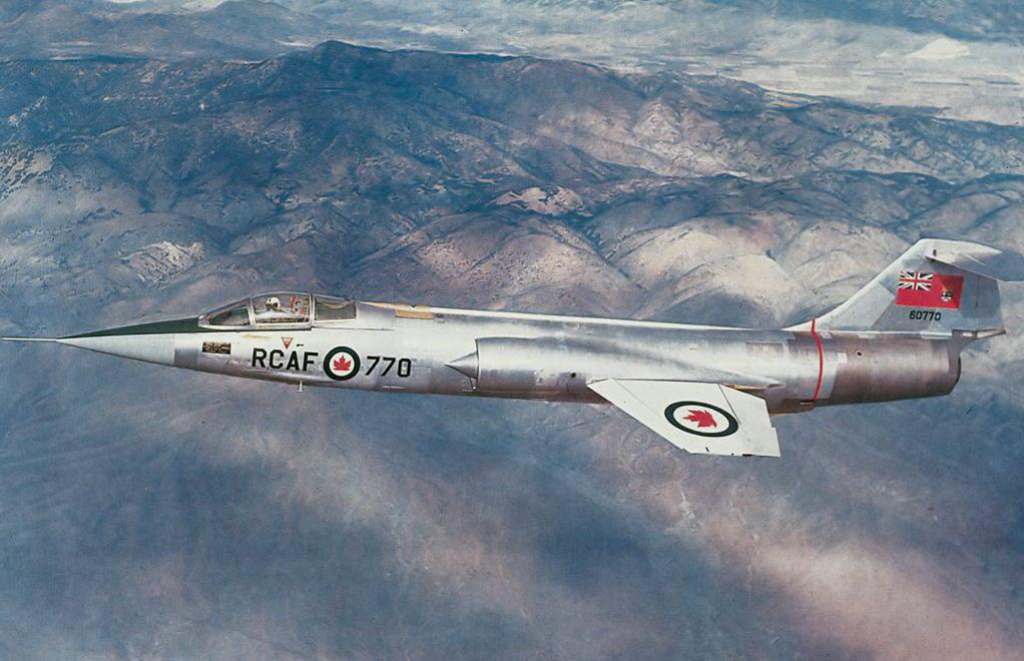
CF-104
This shows that the causes of 75 accidents and disasters ( 32 + 28 + 9 + 6 ) are directly related to the human factor. Compared to other types of Canadian Air Force aircraft, these statistics are, if not the best, then certainly not the worst. For example, in just 12 years of F-86 fighter operation, Canadians have lost 282 aircraft and 112 pilots - 2.6 times more aircraft and 3 times more pilots than the CF-104. The Canadian pilots spoke of the Starfighter as a completely normal aircraft. For example, former CF-104 pilot David Bashow, who flew 2,400 hours, was proud to not have a single scratch on the "Starfighter". In his book Starfighter, he writes: " I've never heard of anyone flying a CF-104 being called a widow maker. The plane was called "deadly aluminum tube", "spear", "flying phallus " ...
By the way, the label " widow manufacturer " was not affixed to the plane by the pilots, but by the journalists. They had reasons for this, because some disasters took the lives not only of pilots but also of ordinary citizens. For example, on May 22, 1983, the traditional " Forest Day " was celebrated in and around Frankfurt. One of the points of the ceremonial program was the acrobatics of five CF-104s from the 439th Squadron of the " Saber-toothed Tigers " of the Canadian Air Force. One plane got out of control and crashed into a highway that crossed the forest. Pilot Alan Stephenson successfully catapulted, but the wreckage hit the local pastor's car and killed his entire family. 6 people died. In addition, many vehicles were damaged in the parking lot and the engine crashed near the tennis court.This tragedy caused a huge resonance.
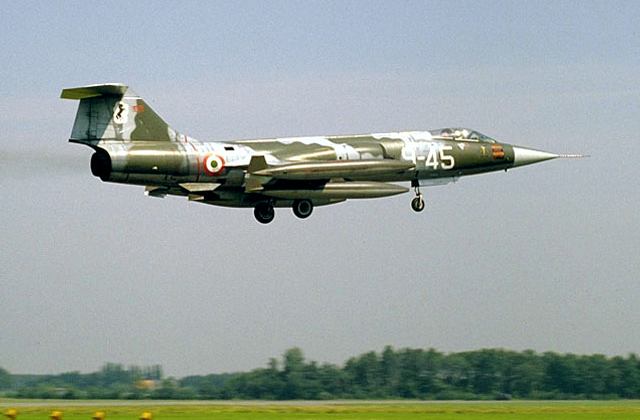
F-104S
The accident rate of the Italian F-104S is also considered relatively high, although lower than the MiG-21. For example, before 1997, 137 aircraft were lost, which is approximately 38% of the total. In 100,000 flight hours, there were 14.7 accidents and incidents with irreversible loss of aircraft. In other countries, Starfighter accidents were lower. For example, in Norway - only 10.7 aircraft per 100,000 flight hours, while in Spain their number was generally close to zero. In Japan, the F-104J also earned a reputation and nickname " Eiko " ( in Japanese - fame ). In 24 years of service, only 3 aircraft were lost.
In conclusion, in terms of relative accidents, the Starfighter did not actually excel against the background of other aircraft of its time. Most accidents with this type of aircraft are the result of the human factor. As for its damaged reputation, it is directly related to the operation of the aircraft in Germany, where the F-104G accident rate actually exceeded the " psychological threshold ", which in combination with corruption scandals led to the presentation of the " Starfighter " in the press in an exclusively negative way. Well, then everything went like a familiar statement: “ First you work for your reputation and then your reputation works for you. The negative " stuck " to the aircraft as a label, although from a purely technical point of view, the F-104 was quite a reliable machine.
Author: Alexandr Čečin (Александр Чечин)
Source
Aviacia i vremia Magazine 4-2016 (Journal of Aviation and Time 4-2016)
Join us
We believe that there are people with different interests and experiences who could contribute their knowledge and ideas. If you love military history and have experience in historical research, writing articles, editing text, moderating, creating images, graphics or videos, or simply have a desire to contribute to our unique system, you can join us and help us create content that will be interesting and beneficial to other readers.
Find out more